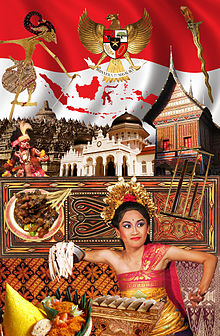
Back Suku bangso di Indonesia BBC Etnias de Indonesia Spanish Indonesian kansat Finnish Groupes ethniques d'Indonésie French Kelompok etnik di Indonesia ID インドネシア諸族 Japanese Suku Bangsa ing Indonesia JV Foko ao Indônezia Malagasy Kalompok etnik di Indonesia MIN Индонезийн ард түмэн Mongolian
| Part of a series on the |
| Culture of Indonesia |
|---|
 |
| People |
| Languages |
| Mythology and folklore |
| Cuisine |
| Literature |
| Music and performing arts |
| Sport |
There are 1,340[1][2] recognised ethnic groups in Indonesia, making it one of the most diverse countries in the world. The vast majority of those belong to the Austronesian peoples, with a sizeable minority being Melanesians.[3][4][5][6] Indonesia has the world's largest number of Austronesians and Melanesians.
Based on ethnic classification, the largest ethnic group in Indonesia is the Javanese who make up about 40% of the total population. The Javanese are concentrated on the island of Java, the world's most populous island, particularly in the central and eastern parts. It is also the largest ethnic group in Southeast Asia. The Sundanese are the next largest group; their homeland is located in the western part of the island of Java and the southern edge of Sumatra. The Sunda Strait is named after them.[7] The Malays, Batak, Madurese, Betawi, Minangkabau, and Bugis are the next largest groups in the country.[8]
Many ethnic groups, particularly in Kalimantan and Papua, have only hundreds of members. Most of the local languages belong to the Austronesian language family, although a significant number of people, particularly in eastern Indonesia, speak unrelated Papuan languages. Indonesians of Chinese, Arab and Indian descent each make up less than 3% of the total Indonesian population.[8]
The classification of ethnic groups in Indonesia is not rigid and in some cases unclear due to migrations, cultural and linguistic influences; for example, some may consider the Bantenese to be members of the Sundanese people; however, others argue that they are different ethnic groups altogether since they have their own distinct dialects. This is also the case with the Baduy people, who share many cultural similarities with the Sundanese people. An example of hybrid ethnicity is the Betawi people, descended not only from marriages between different peoples native to Indonesia, but also intermarriages with Arab, Chinese and Indian migrants since the era of colonial Batavia (modern-day Jakarta).
- ^ Na'im, Akhsan; Syaputra, Hendry (2011). "Kewarganegaraan, Suku Bangsa, Agama dan Bahasa Sehari-hari Penduduk Indonesia" (PDF) (in Indonesian). Statistics Indonesia. Archived (PDF) from the original on 23 September 2015. Retrieved 23 September 2015.
- ^ "Mengulik Data Suku di Indonesia" (in Indonesian). Statistics Indonesia. 18 November 2015. Retrieved 1 January 2021.
- ^ Taylor 2003, pp. 5–7.
- ^ Witton 2003, pp. 139, 181, 251, 435.
- ^ Dawson, B.; Gillow, J. (1994). The Traditional Architecture of Indonesia. London: Thames and Hudson Ltd. p. 7. ISBN 978-0-500-34132-2.
- ^ Truman Simanjuntak; Herawati Sudoyo; Multamia R.M.T. Lauder; Allan Lauder; Ninuk Kleden Probonegoro; Rovicky Dwi Putrohari; Desy Pola Usmany; Yudha P.N. Yapsenang; Edward L. Poelinggomang; Gregorius Neonbasu (2015). Diaspora Melanesia di Nusantara (in Indonesian). Direktorat Sejarah, Direktorat Jenderal Kebudayaan, Kementerian Pendidikan dan Kebudayaan. ISBN 978-602-1289-19-8. Archived from the original on 25 December 2022. Retrieved 24 August 2022.
{{cite book}}:|website=ignored (help) - ^ Ananta, Aris (29 April 2016). Demography of Indonesia's Ethnicity. Flipside Digital Content Company Inc. ISBN 978-981-4695-94-7.
- ^ a b Suryadinata, Leo; Arifin, Evi Nurvidya; Ananta, Aris (2003). Indonesia's Population: Ethnicity and Religion in a Changing Political Landscape. Institute of Southeast Asian Studies. ISBN 9789812302120.